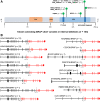Targetable BRAF and RAF1 Alterations in Advanced Pediatric Cancers
- PMID: 32918774
- PMCID: PMC7794197
- DOI: 10.1002/ONCO.13519
Targetable BRAF and RAF1 Alterations in Advanced Pediatric Cancers
Abstract
RAF family protein kinases signal through the MAPK pathway to orchestrate cellular proliferation, survival, and transformation. Identifying BRAF alterations in pediatric cancers is critically important as therapeutic agents targeting BRAF or MEK may be incorporated into the clinical management of these patients. In this study, we performed comprehensive genomic profiling on 3,633 pediatric cancer samples and identified a cohort of 221 (6.1%) cases with known or novel alterations in BRAF or RAF1 detected in extracranial solid tumors, brain tumors, or hematological malignancies. Eighty percent (176/221) of these tumors had a known-activating short variant (98, 55.7%), fusion (72, 40.9%), or insertion/deletion (6, 3.4%). Among BRAF altered cancers, the most common tumor types were brain tumors (74.4%), solid tumors (10.8%), hematological malignancies (9.1%), sarcomas (3.4%), and extracranial embryonal tumors (2.3%). RAF1 fusions containing intact RAF1 kinase domain (encoded by exons 10-17) were identified in seven tumors, including two novel fusions TMF1-RAF1 and SOX6-RAF1. Additionally, we highlight a subset of patients with brain tumor with positive clinical response to BRAF inhibitors, demonstrating the rationale for incorporating precision medicine into pediatric oncology. IMPLICATIONS FOR PRACTICE: Precision medicine has not yet gained a strong foothold in pediatric cancers. This study describes the landscape of BRAF and RAF1 genomic alterations across a diverse spectrum of pediatric cancers, primarily brain tumors, but also encompassing melanoma, sarcoma, several types of hematologic malignancy, and others. Given the availability of multiple U.S. Food and Drug Administration-approved BRAF inhibitors, identification of these alterations may assist with treatment decision making, as described here in three cases of pediatric cancer.
Keywords: Biomarkers; Brain neoplasms; Leukemia; Pediatrics; Precision medicine; Proteins B-raf; Proto-oncogene; Tumor.
© AlphaMed Press 2020.
Conflict of interest statement
Figures







References
-
- Siegel RL, Miller KD, Jemal A. Cancer statistics, 2015. CA Cancer J Clin 2015;65:5–29. - PubMed
-
- Worst BC, van Tilburg CM, Balasubramanian GP et al. Next‐generation personalised medicine for high‐risk paediatric cancer patients ‐ The INFORM pilot study. Eur J Cancer 2016;65:91–101. - PubMed
-
- Miller KD, Siegel RL, Lin CC et al. Cancer treatment and survivorship statistics, 2016. CA Cancer J Clin 2016;66:271–289. - PubMed
-
- Slamon DJ, Leyland‐Jones B, Shak S et al. Use of chemotherapy plus a monoclonal antibody against HER2 for metastatic breast cancer that overexpresses HER2. N Engl J Med 2001;344:783–792. - PubMed
-
- Druker BJ, Talpaz M, Resta DJ et al. Efficacy and safety of a specific inhibitor of the BCR‐ABL tyrosine kinase in chronic myeloid leukemia. N Engl J Med 2001;344:1031–1037. - PubMed
MeSH terms
Substances
LinkOut - more resources
Full Text Sources
Medical
Research Materials
Miscellaneous

